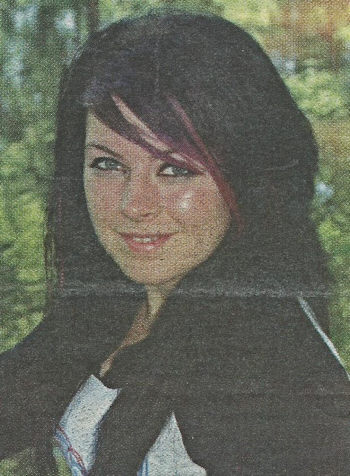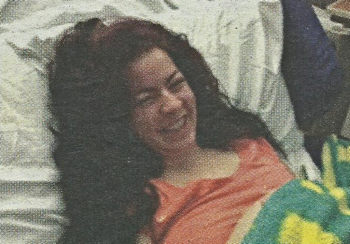Contact: Dolores (Mohr) Kenyon
E-mail: dolores@wiclarkcountyhistory.org
Surnames: Baker
----Source: Thorp Courier, (Thorp, Clark Co., WI) 9/05/2012
Beating the Odds (Katy Baker – 2012)

Back in May of 2012 18-year old Katy Baker was known as an above average teenager. A 2012 graduate of Thorp High School—graduating in the top 10 percent of her class—Katy was already undertaking college-level courses at UW-Marathon County, preparing for medical school. But on Monday, June 11, only 17 days after graduation, her life was turned upside down when she was a passenger in a serious car accident. The car rolled twice, and Katy was ejected from the vehicle. After being transported to St. Joseph’s Hospital in Marshfield, they found that the accident had caused a crushed adrenal gland, a split liver and spleen, a broken scapular bone, a broken pelvic bone and two broken vertebrae. Among her list of injuries, Katy also suffered a Diffuse Axonal Injury (DAI)—a result of a twist and tear of the connections between the cells of the brain—causing Katy to go into a coma.
Katy’s mother, Natalie Baker, recounted the doctors’ initial reactions to Katy’s initial MRI, saying, “They were shaking their heads and told me that they didn’t know if she would wake up. It was a very frightening first few days in the Intensive Care Unit.”
Doctors rated Katy as a level three coma, which is considered the most severe level of unconsciousness on the Glasgow Coma Scale. Reports show that only 10 percent of level three coma patients wake up, and those who do live with severe physical and mental impairments.
Although still in a coma and the prognosis seeming bleak, Katy showed signs of improvement within a few days, already beginning to move her eyes behind the eyelids and improving her breathing to a point where she was taking 100 percent of her own breaths without a machine by day six. Day nine was a big one for Katy’s recovery as she opened her eyes for the first time.
“She opened her eyes, but she wasn’t focusing,” explained Natalie.
By day 10, Katy was conscious for a majority of the day and was responsive—holding up fingers when prompted, but they were not done in the right quantities. Throughout the day, Katy’s breathing tube was removed, she was able to swallow and cough, but she still had quite a bit of fluid in her throat. After some additional assessments, doctors were able to share with Natalie that Katy’s numbers were improving.
Coming out of such a serious coma, Katy had a long road of recovery ahead of her, but over the course of the next couple weeks, Katy was making progress at an incredible rate—beating the statistics regarding most DAI patients. With her mother by her side, reading to her and playing comforting music, Katy began to show more and more signs of a recovery, including beginning to make repetitive sounds, focusing on objects, and staying awake for longer periods of time. On day 19, Natalie had a moment of yearning for the Katy she knew and loved.
“I missed my Katy so much—seeing her picture with her friend in a photo booth making silly faces,” Natalie described. But it was on that same day that Katy began following Natalie with her eyes. “Some of the expressions she was making were the same as when she was a baby. It brought back a lot of memories.”
By week three in the hospital, Katy had begun working more with Occupational, Physical, Speech/Cognitive, and Music therapists. Because Katy’s stimulation was strictly limited, including having visitors, Natalie began a blog, explaining the progress Katy had been making, and in one post, Natalie described one specific day in Katy’s third week of recovery, saying “She is getting frustrated at times. I’m sure it is because she wants to communicate but hasn’t quite figured that out yet. But I’m sure she will.” Natalie was correct. The very next day, a Chaplain stopped by Katy’s room to check in. During his visit, he told her that she had pretty hair and Katy whispered back, “Thank You”—the first time she had put together words rather than repetitive sounds. Only two days later, Katy took two steps during therapy, another monumental sign of improvement.

“It was like she was growing up all over again,” Natalie stated.
As Katy’s frontal lobe continued to heal, her cognitive abilities continued to improve. She began repetitively counting, reciting times tables, and even speaking and teaching the hospital staff Spanish. Once her therapist found out Katy’s love of math, she introduced more math problems into her treatments and Katy responded magnificently. Even though she was showing such amazing advancement in her recuperation, Katy was still ordered to limit her stimulation, including guests, TV, and radio.
“Everyone said she was doing amazingly great, but she was confused and restless,” explained Natalie. “The doctors said it would pass—that she was just going through a phase.” Sure enough, Katy’s speech improved to a point where she was piecing together meaningful sentences, was responding to questions, and began reading signs along the hospital corridors. After a while, she began asking for things like music and water. But to Natalie, the real music was hearing Katy begin to laugh again.
Over the course of the next couple weeks, with the goal of getting home in August, Katy pushed herself to regain her strength—both mentally and physically. She began reading on her own, gaining mobility, and even dictated a statement for her recovery blog.
“It is really awesome to have nurses or doctors come in who have not seen her for a week, or even a few days, who marvel at the differences,” Natalie explained. It wasn’t long before the doctors, nurses, and therapists informed Katy that the end was in sight, and before she knew it, Tuesday, August 14 had arrived, and Katy got a chance to say goodbye to St. Joseph’s and finally head home.
“After reading that only 10 percent of severe DAI patients ever wake up, my gratitude has deepened even more. I am blown away and now I see why some of the doctors were so grave when we first got here. I avoided reading too much on it at first and I am glad I did. I would have been horribly worried and that sure wouldn’t have helped.” Natalie said.
Today, Katy is living an extremely positive, focused, and grateful life. Whether she’s at one of her three-times-a-week therapy sessions or working on cognitive-building puzzles, her attitude exudes optimism. “I’m thankful it happened,” Katy said. “It made me a better person.” “Everything she says is positive,” added Natalie. Both Katy and Natalie had many words of appreciation and thanks for the many people who have helped throughout Katy’s recovery, including all of the words of encouragement, offers to help back at their home while they were in Marshfield, the hospital staff, and the Ronald McDonald House organization.
Despite a treacherous summer, Katy still has big plans for the fall. Because of her doctor-ordered limitations on stimulation, Katy will be continuing her college education by taking seven credits worth of classes online. Following a medical review in a couple months, Katy hopes to be ready to move into the dorms at the University of Wisconsin-Eau Claire in time for the 2013 spring semester and still plans on attending medical school.
Going from a level three coma to completely functioning and already preparing for more college courses within two months, Katy has challenged the statistics and defied the odds. In fact, Katy’s mother Natalie said it best: “She’s a miracle.”
If you would like to read more about Katy’s miraculous recovery process, visit Natalie’ blog at www.katybakersrecovery.blogspot.com.
